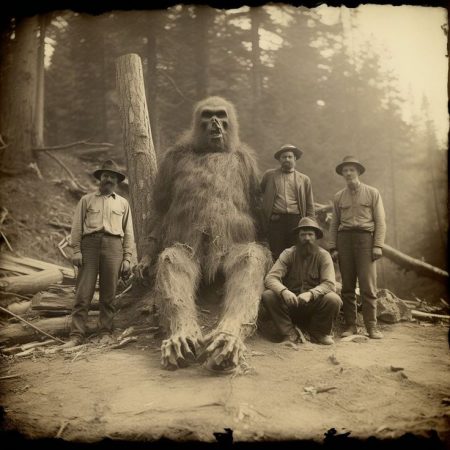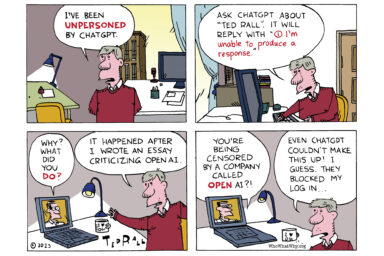Disinformation-as-art erodes our reality from the periphery.
|
Listen To This Story
|
I first got onto Pinterest to gather pictures for some project — who can even remember now? — and over time, the tide of the app’s algorithm pulled me gently to an island of images unlike anything else I’ve seen online. They appeared to be old photographs, sepia or black-and-white, grainy or aged. People in vaguely 19th-century period dress — vests, homespun dresses, hats, beards — gathered in a town square or a forest or a field, staring that desolate stare that we associate with photos of the long-dead.
Each of these photos had a single fantastical element. It could be a giant, a robot, an alien, or a mythical creature. Other vintage shots hinted at Lovecraftian monstrosities or the unearthed ruins of advanced civilizations. One user presented a series of photos of really big livestock. How do you get a goose this goddamn big? “Early 19th-century gene modification.”
I love them for the stories they suggest. What happened to the villagers after they shook hands with the alien? How do you get a unicorn to pose? Do we really need another giant cyborg housecat?
Seems like everyone’s out here having fun with AI-generated images, cross-pollinating each other’s ideas. It is, near as I can tell, a new genre: disinformation as art.
The intention is not to deceive, though there are cases that come uncomfortably close to the edge. Some images, like a Bigfoot, feel like wish-fulfillment for long-suffering paranormal researchers; others, like a shot of an Antarctic pyramid supposedly taken around 1912, are catnip for ancient-alien conspiracists taking a short break from the History Channel.

I’ve comforted myself as I collect these images that even though some people might think they are real, at least I have a keen sense of where truth’s boundary lines are drawn (even if they are drawn in chalk). You probably feel the same. But then you see a French tank-cycle straight out of “Mad Max at the Moulin Rouge” and you start doubting concepts like “the past” and “the future.”
It took longer than I’d like to determine via a website called “HistoryGarage.com” that the tank-cycle was an actual prototype from the 1930s. But even bolstered by the (I’m sure) trusty bona fides of HistoryGarage.com I still can’t be entirely sure. With only so many hours in the day, I push the red button marked “Believe” in my mind and move on.
Such is the template for Life Online now. We have to navigate between what we think is real and what is not, and we have to do it at speed, like those border collies that slalom through the poles at Westminster’s agility trials. Unlike the dog, we don’t get a best-in-show ribbon; we get a patchwork sense of reality that we must constantly maintain and update, and that is not as good as a ribbon.

***
We journalists like to think of ourselves as an immune system for the body politic. We keep society healthy by addressing untruths, rumors, and superstitions, and we also have annoying allergic responses to certain foreign bodies. But you really see the immune response activated for big viral lies like a Biden deepfake or AI-generated revenge porn. We understand that this fake content is dangerous because it unseats our reality for immediate purposes, say, an upcoming election.
But a fake image of a big Victorian cow? That’s innocent, or agnostic: It’s merely trying to replace our reality with something a little more interesting. So there’s not the same urgency for journalists to act as quality control for the truth about things like whether or not archeologists are unearthing stargates.
And all this disinformation is about to go into overdrive. OpenAI, the company behind ChatGPT, just released Sora, a new model that creates video from text prompts. The first outputs are extraordinary, from photorealistic images of a human eye blinking to Pixar-level animation of a dancing kangaroo. The news media is slack-jawed with wonder; once again, the future was a lot closer than we thought.
Me, I can’t get enough of the Sora-generated drone footage of a California Gold Rush town.
I watch it over and over. I want to climb into it. I want to walk around. There’s a robot in there somewhere, I’m sure of it.
***
The great danger of this disinformation-as-art is that it’s both cool and fun, meaning people are probably going to make, and consume, too much of it. Thus, the category of Vintage Paranormal photos is just one of hundreds or thousands of other micro-genres. One of my favorites is something I’d call “Pope Francis DGAF.” Here, the current Papa’s popularity is transmuted into holy kitsch. You can experience, for example, the Supreme Pontiff of the Universal Church on the ones and twos; or commune with the Vicar of Jesus Christ’s dance floor power; or gaze in awe upon the Primate of Italy both shredded and inked for God.
This bloom of papal content comes directly out of an AI image of Francis in a puffer coat that became a meme in 2023. When it first appeared, journalists rushed to fact-check while fretfully/gleefully wringing their hands.
“Many public figures — including the basketball star LeBron James and various Real Housewives — have popped up in A.I.-generated pictures recently, but the images with Francis have made the biggest splash,” The New York Times reported in the early days of the pope craze. “They have earned more views, likes and comments than many other A.I. photos … prompting a race to depict the 86-year-old in odder and odder situations.”
Look, you might say, I have an education and a job and can wear a belt and am smart enough to know that the pope isn’t really on a skateboard, so why is all this an issue? To which I say — sure, I thought so too, but then I saw an image of Francis autographing a Popemobile-styled Lamborghini and, as with the French tank-cycle, I did not know if it was real.
Friends: it is. (Sidenote: Maybe I just have a problem determining the reality of exotic European vehicles.)
The pope and a Lambo? Absurd! Yet it exists. It happened. And it proves that the line between what we can comfortably call real and not isn’t as sharp as even the most educated and media-savvy of us would like to believe.

While journalism might confront the most egregious AI-generated lies, there’s all this other… stuff… this disinformation-as-art, that percolates all around us. Too weird to bother with, it’s eating away at history in tiny, subtle ways. If you don’t go in search of a fact-check for liminal examples like the pope’s Lambo, you might file it away as false; or, alternatively, you might idly accept that the Servant of the Servants of God actually went to Burning Man one time.
***
For maybe six months, I thought the actor Chris Cooper was dead. I’d heard it, I never bothered to check, and then when I’d see him in a movie I’d feel the wistfulness you feel when you’re watching a talented person who you know won’t be doing more talented things. He was so good, you think, sadly.
And then you find out you’re wrong, and you’re euphoric at the revocation of death, for a moment, right before feeling the creeping sensation of sinking into quicksand, which you thought was the living room rug, or the driver’s seat of your car, or the sidewalk of your city in which real people go about their real lives among real businesses and real schools, supposedly.
This is my fear of fake vintage aliens: not that we’re fooled by the big center-stage events of history, but that our knowledge base is constantly eroded by the swarms of cool, fun, tiny falsehoods at the periphery.
It’s no coincidence that a lot of the vintage art is adjacent to popular conspiracy theories. Implicit in the “age” of the photos is the sense that there’s a significant truth that we have lost access to… or that was intentionally concealed.
Questioning the 1969 moon landing while on the go? Maybe you see some convincing images “proving” it was staged and, with no time to check their provenance, you push that “Believe” button in your brain and are still able to catch that sale at Lululemon, satisfied at the total collapse of your faith in the United States, scientific progress, and, hell, maybe the moon itself.
***
A Facebook group called “SEA Heritage and History” promotes Indonesian culture to its 531,000 followers. In August 2022 it dropped a fascinating post about an explorer named Alfred Isaac Midleton, who supposedly “traveled the farthest reaches of the globe during the late 19th century in search of zoological, botanical and archeological wonders.” He and his team apparently vanished into the Sumatran jungles in 1901 during an expedition “to uncover the fabled Lost City of Dawleetoo. Due to these tragic events, scant details are known about what you see in these fascinating photos.” It’s unclear how the photos in question were recovered, but oh the story they tell: fantastic ruins that look eerily advanced, almost aerodynamic.

Midleton’s story bounced around Facebook, Twitter, and Instagram, where users repeated the story with that tone of “just asking questions” that is the lingua franca of trolls and true believers.
Midleton did not exist, though he’s based on real explorers like Percy Fawcett. The truth is hidden in the names: “Alfred Isaac” — “AI”; “Dawleetoo” — “Dall-E 2,” the AI art generator. One debunker traced the story’s origins to a VFX designer who created it for fun, after which the “mystery” took on a life of its own.
And that’s how “disinformation-as-art” evolves to lose its little tail and become, simply, “disinformation.”
***
Do these peripheral untruths have any kind of large-scale effect? Does it really matter whether or not people think “Dawleetoo” was a real place built by actual aliens?
It at least seems like the abundance and visibility of this “vintage disinformation” can encourage belief. Kelly M. Greenhill, a professor of political science at Tufts University and author of books on conspiracy theories, said in an interview that for mis- or disinformation, “what fundamentally matters — as it always has — is the content of the message (its salience to the audience),” and that “the more we hear information, the more it feels ‘true’ to our brains.”
It’s hard to imagine a mob of “Midletonians” storming the Smithsonian demanding disclosure on Dawleetoo. But then, it was once hard to imagine a lot of things getting stormed that now get stormed. According to a 2022 review of conspiracy theories, “an unintended consequence of conspiracy theories is their potential to increase further the social exclusion of believers, which may lead an individual further down the rabbit hole when seeking out their newfound community.” That isolation could, the study says, lead to familiar outcomes: “refusal to pay taxes and committing violence against a person in power.”
You may think it’s absurd that Pinterest’s collection of vintage aliens could destabilize Western society. But maybe you haven’t yet had an encounter with your own version of a pope-branded Lamborghini. The internet changes us, and it does so with the tiny movements of tiles pried out and replaced in a mosaic whose dimensions we can’t perceive.
We don’t notice the image shifting, but one day, we wake up and everything’s different. We have created for ourselves a more interesting reality. What do we do with the old one?




